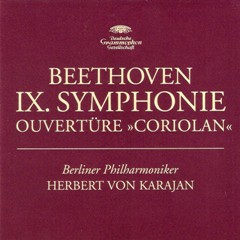111 Years of Deutsche Grammophon - CD 26
111 Years of Deutsche Grammophon - CD 26
Beethoven: Overture "Coriolan"; Symphony No.9

1 Overture "Coriolan", Op.62 [9:00] Symphony No.9 in D minor, Op.125 - "Choral" 2 1. Allegro ma non troppo, un poco maestoso [15:28] 3 2. Molto vivace [11:00] 4 3. Adagio molto e cantabile [16:25] 5 4. Presto [6:22] 6 5. Presto "O Freunde, nicht diese Töne!" -Allegro assai [17:32] Gundula Janowitz – soprano Hilde Rössel Majdan – contralto Waldemar Kmentt - tenor Walter Berry - bass-baritone Wiener Singverein Reinhold Schmid – choir master Berliner Philharmoniker Herbert von Karajan – conductor
The Coriolanus Overture (German: Ouvertüre Coriolan, Op. 62) is a composition written by Ludwig van Beethoven in 1807 for Heinrich Joseph von Collin's 1804 tragedy, not, as is sometimes claimed, for Shakespeare's play.
The Symphony No. 9 in D minor, Op. 125, is the final complete symphony of Ludwig van Beethoven. Completed in 1824, the symphony is one of the best known works of the Western classical repertoire. Among critics, it is universally considered to be among Beethoven's greatest works, and is considered by some to be the greatest piece of music ever written. It has been adapted for use as the European Anthem.
The symphony was the first example of a major composer using voices in a symphony (thus making it a choral symphony). The words are sung during the final movement by four vocal soloists and a chorus. They were taken from the "Ode to Joy", a poem written by Friedrich Schiller in 1785 and revised in 1803, with additions made by the composer.
The Philharmonic Society of London originally commissioned the symphony in 1817. The main composition work was done between autumn 1822 and the completion of the autograph in February 1824. However, both the words and notes of the symphony have sources dating from earlier in Beethoven's career.
The title of Schiller's poem "An die Freude" is literally translated as "To Joy", but is normally called the "Ode to Joy". It was written in 1785 and first published the following year in the poet's own literary journal, Thalia. Beethoven had made plans to set this poem to music as far back as 1793, when he was 22 years old.
In addition, the symphony also emerged from other pieces by Beethoven that, while completed works in their own right, are also in some sense sketches for the future symphony. The Choral Fantasy Opus. 80 (1808), basically a piano concerto movement, brings in a chorus and vocal soloists near the end to form the climax. As in the Ninth Symphony, the vocal forces sing a theme first played instrumentally, and this theme is highly reminiscent of the corresponding theme in the Ninth Symphony (for a detailed comparison, see Choral Fantasy). Going further back, an earlier version of the Choral Fantasy theme is found in the song "Gegenliebe" ("Returned Love"), for piano and high voice, which dates from before 1795.








